Newsletter 138, November 2021

In this issue
President's Update
FGLT Board elections
Many thanks to all who participated in last month’s Forest Growers Levy Trust elections for Board positions. The unofficial results provided to me are:
There were 344 individual votes.
326 voted for two people.
18 voted for only one person.
Voting by candidate resulted in:
- Graham West 299
- Bert Hughes 281
- Ian Jackson 76
- Glenn Williams 14
A great result, I very much appreciate the support I have received, thank you.
The first Board meeting Bert and I are eligible to attend will be held on December 2nd at the ForestWood Centre in Wellington or by Zoom.
Overall, this election appears to be a considerable step up in participation by small scale growers. Well done to all those that encouraged a better voter turnout and helped with communication.
My sincere thanks to Ian Jackson for his lengthy service on this Board. Ian was instrumental in the early stages of setting up several agreements and structures to make this Levy work for Farm Forestry. It is voluntary and selfless work that requires considerable preparation time to participate effectively. Thanks again Ian.
SME Committee Meeting
The FGLT Small and Medium Enterprise committee met on 15 Oct in Wellington. As mentioned last month, this is one of nine committees that interface between the levy payers, the secretariat, and the Board. The SME Committee has been struggling to remain funded and while supported mainly by NZ FFA committee members, it represents the interests of all SMEs. We hope to broaden the committee membership. Please make contact if you wish to participate.
This committee currently has a budget allocation of $124,572 per year for research projects. One of the committee’s important roles is to annually receive and rank the research proposals. In past years this committee has championed and funded projects addressing harvesting costs of small forests. It also provides oversight across all activity and actions of the other committees that concern SMEs.
FGR Conference
The Forest Grower Research Conference of primarily Levy projects (19 – 21 Oct) had to be by Zoom this year. However, this gave all forest growers the opportunity to receive the presentations via the internet and post questions. I would be interested to know how many of you found this useful.
I contributed a presentation on “Integrating information for Site Specific Management.” This attempted to make the case that because many research results are site specific, SMEs need tools that integrate various research elements and make it applicable to their specific property or forest. The new Treefarmer tool is a first attempt to do this. https://treefarmer.fgr.nz/
All the presentations will be made available on the Forest Growers Research (FGR) web site and each presentation is only 15 minutes. Please check it out. https://fgr.nz/2021/09/17/forest-growers-conference-2021-webinar-2021/
Carbon Forestry
The BOP Branch ran an open seminar on 28 Oct, titled “What is the Carbon Opportunity”. For some time, we have had many carbon questions being raised at all our field days and decided there is considerable appetite for better information. The seminar attracted 43 attendees (with several apologies from those locked down) and a lot of lively interest. I suggest this is a topic that Farm Forestry can use to make itself relevant to many landowners. BOP Branch has two forestry consultants on the committee and hence this made it easier for us to prepare technical information. However, if not present in your Branch membership, consultants can easily be brought in given the opportunity to advertise their services.
We included two farmer case studies. These were the highlight of the seminar and received the most favourable comments in the feedback sheets. We also brought in officials and Wellington experts by video to fill gaps around regulations and carbon trading.
It was surprising how diverse the organisations were that attended. In addition to our members, there were Regional Council staff, farmers, consultants, accountants, and banks.
We hope to attract new members by keeping in touch with this group and will next be running a field day on carbon and looking at a range of species and older long rotation forests.
If I can help you with your own branch seminar, please don’t hesitate to make contact.
Keep well
Graham West
Quick Links
- See a Swedish Skyscraper made entirely of wood, making it one of the world's tallest wooden buildings.
- Takeover of Forestry firm approved The Overseas Investment Office has approved the deal for two European pension funds to buy a majority stake in an Otago Forestry company, but the value of the deal will be kept secret.
- How Pine became our exotic timber of choice The rapid milling of native timber in Southland – rimu, mātai, kahikatea, miro and tōtara– gave rise to concern about how long the supply would last...
- Tasmanian love-heart forest Hundreds of native trees have been planted in the shape of a heart to promote tourism and regenerative work.
Events
For more information on these events, they are posted on the NZFFA website »
Branch secretaries, please make sure you notify head office of any branch or action group events.
- NZDFI Field Day - Developing a Sustainable Hardwood Industry in Marlborough Wednesday 10 November 2021 Join us for a series of site visits to see plantings of durable eucalypts of different species and ages; also how trees can be converted into…
- Combined Action Group Weekend in Northland - Cypress and Eucalyptus 19 to 21 November 2021 - Friday to Sunday. Hosted by Tim Rose and Dean Satchell. A basic itinerary as follows: Meeting and dinner on Friday night in Kerikeri. Accommodation…
- South Otago Field Day - Clinton Friday 19 November 2021 2pm South Otago Farm Forestry Branch have a field day coming up on Friday 19 November 2021 2pm at the Pearce Property, 587 Slopedown Road, Clinton.…
- Nelson Branch Field Day - Songlines Forest Saturday 27 November 2021 10am Nelson Branch next Field Day and Meeting will be at James Mathieson’s “Songlines” forest near Tapawera on Saturday 27 November. James, after 20 years of…
- NZFFA Council Meeting, Seminar & Field Trip - Rotorua Tuesday 30 November - Wednesday 1 December 2021 Tuesday 30 November 2021 8.30am -12.30pm National Council Meeting at the Distinction Hotel Rotorua followed by lunch. To be attended by Councillors or…
- Wairarapa Branch Field Day - Gladstone Saturday 4 December 10.30am - 12.30pm Visit to the de Jong property, Admiral Road, Gladstone Stephen and Frances de Jong bought their 10.6 ha property in 1990. 3.6ha of original…
Blogs
NZFFA members can set up their own blogs on the NZFFA website. Email Dean.
Headlines
- New Zealand Forest Owners sign on to International Wood Manifesto leading into COP26 October, 2021. The New Zealand Forest Owners Association has joined 17 other forest and timber organisations around the world in launching the International Wood Manifesto in London, to lead into the crucial…
- Forest Owners say ‘back the bat’ October, 2021. The Forest Owners Association is urging its members and the public to vote for the pekapeka – the Long-Tailed Bat - in the Forest and Bird sponsored Bird of the…
- Forest Owners says extra planting ‘just as well’ given slippage on carbon reduction targets October, 2021. The Forest Owners Association is saying that foresters’ intentions to plant more trees is an immediate and practical insurance against New Zealand not achieving greenhouse gas reduction goals. The Association…
Farm Greenhouse Gas and Sequestration Calculator
Howard Moore, Wellington Branch
In preparation for managing on-farm greenhouse gas emissions under He Waka Eke Noa, Beef+Lamb is offering a free GHG calculator to help farmers measure emissions and sequestration. As this will be an important tool, I’d like some feedback on how difficult it is to use, and what you think of the results. You’ll find it here: https://beeflambnz.com/ghg-calculator-and-action-plan#access.
This site will give you instructions and step-by-step video guides, but to actually use the calculator you’ll need a Beef+Lamb on-line account. I haven’t tried the calculator myself because I don’t have an account, and while I could create one I know nothing about farming so I’d be bound to cock it up. An item in Farmers Weekly suggested it could take 25 minutes to work through, but I’d like to know your experience. How long does it take to use? What does it take into account, and what does it ignore? What you think of the sequestration part of the calculator? How accurate do you think it might be in relation to the ETS?
If you are caught by the definition of ‘farmer’ under He Waka Eke Noa you will be required to use a calculator like this, but if you’re not you might wish to pass. The current definition of a farmer is anyone owning a farm of over 80 ha, or a dairy farm with a milk supply number, or a cattle feedlot.
Any takers?
Springtime
Words & photos by Tess Smith, Waikato Branch
Since living in this piece of paradise we have been enjoying the Spring flowering of the Paulownia trees and also plantings nearer the house to encourage our native birds. I am pleased to be able to enjoy our native Tui, Waxeye and Kereru or Woodpigeon as the young leaves begin to emerge and copious amounts of flowers cause a symphony of birdsong here, so thought I would share a few shots of these for you to enjoy too.
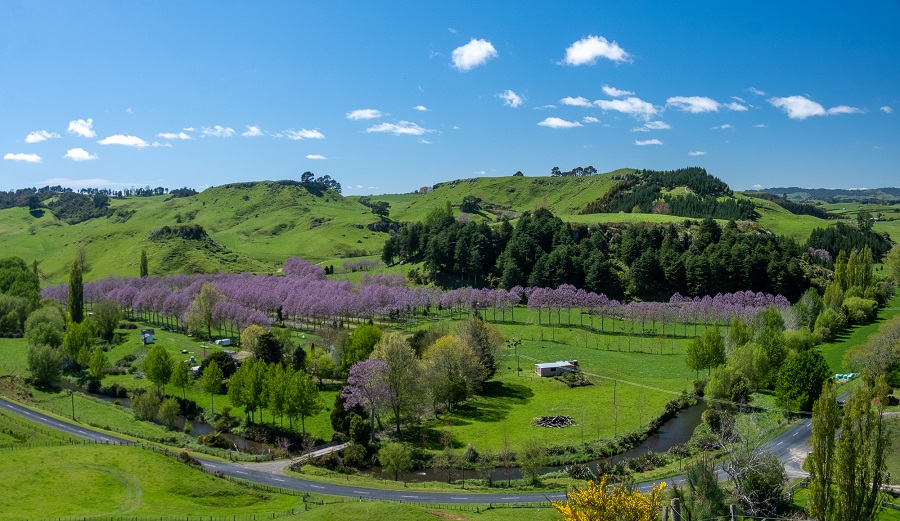
The Warratah is only in its 4th year and has over 30 blooms covering it, with the lean evident it may need a hard cut back to help it remain in situ, adding a nectar feeding station certainly caused great interest as well.
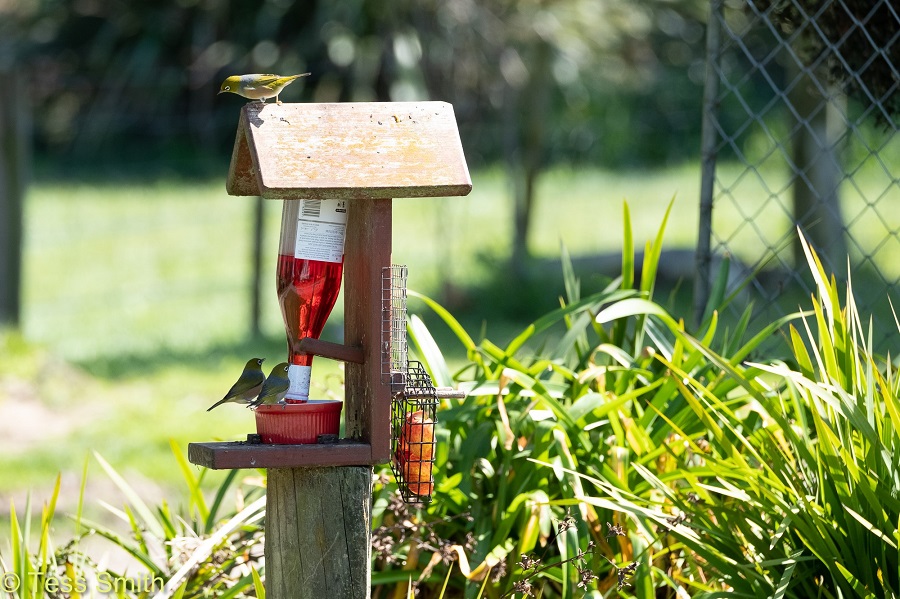
And as I sit here writing and putting this together the Bottle Brush planted outside the office window has a regular visitor of Tui who are nesting in the trees along the driveway feeding and singing away, blissful.
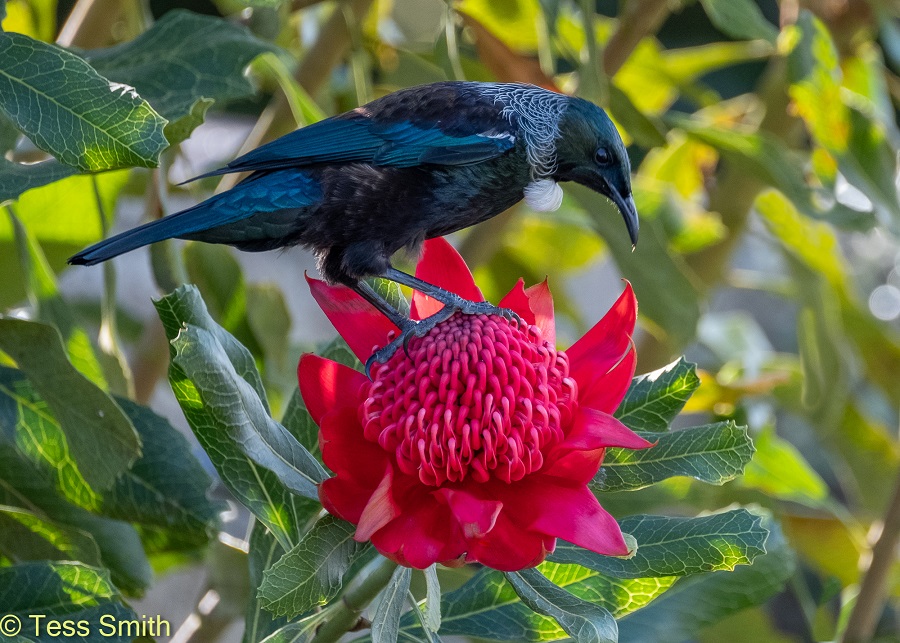
(top)
Conference 2022 -The new normal. Opportunity or threat.
NZFFA Annual Conference 7 - 11 April 2022 Timaru
Programme includes:
- Thursday 7 April - Action Group meetings
- Friday 8 April AGM, Councillor meeting and workshops
- Friday 8 April Opening dinner
- Saturday 9 April - Local farm forestry fieldtrips
- Saturday 9 April - Awards Dinner
- Sunday 10 April – Mackenzie Basin trip
- Monday 11 April – Geraldine trip
Members online Conference Registration or download Registration Form
Setting the standard for the forestry industry - Safetree Contractor Certification and what you need to know
Launched in 2018 by the Forest Industry Safety Council (FISC), Safetree Certification aims to change the safety culture and improve forestry industry standards for all. With more than 250 contractors certified since its inception, it provides an industry standardised assessment of a forestry contractor’s suitability to work.
With more and more people diversifying their investments by planting trees on their land, more are requiring the services of forestry contractors to undertake planting, pruning, thinning and harvesting work. Here, we look at the key benefits of using a Safetree Certified forestry contractor.
Why use a Safetree Certified Contractor?
When you choose a certified forestry contractor, you can be reassured that they’ve achieved an industry standard for professionalism, safety and competency.
- Your contractor is a professional operator
- Your contractor achieves, or exceeds, the industry benchmark for health and safety systems
- Your contractor is competent to do the job at hand
- Your contractor employs workers who benefit from improved health and safety and employment conditions
How do you know a contractor is certified?
Certified contractors are added to a searchable register on the Safetree website https://safetree.nz/contractor-register/.
2022 Certification Changes
In the coming months, key changes are being made to contractor certification to extend and develop the programme. These include:
- Broadening certification to include forest management companies as well as contractors
- More resourcing is being added to allow FISC to manage and administer certification more extensively
- A new software platform called EcoPortal will enable more insight reporting and feedback to ensure continual improvement
- The one-tier model will be extended to a three-tier model to allow different levels of certification and better recognition of contractors demonstrating continuous improvement
- More resource will bring more consistency to the audit process with direct reporting to FISC
- A new communications plan will bring more regularity, transparency and promote the value Safetree Certification provides to all stakeholders
For more information contact Fiona Ewing FISC National Safety Director fiona.ewing@fisc.org.nz
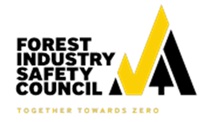
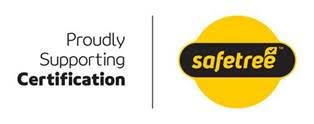
Conservation Status - In Serious Trouble
Photo credit: Colin O'Donnell, Department of Conservation
Forest Owners were encouraging us to "back the bat" and now the Pekapeka-tou-roa has won Bird of the year for 2021!
This wee mammal has taken out the title of Bird of the year in its first year of being included in the competition.
The long-tailed bats live throughout New Zealand, and fly at dusk along forest edges using echolocation calls to hunt moths, mosquitoes, and other yummy insects. They are as small as your thumb, the wingspan of your hand, and weigh the same as a $2 coin.
Pekapeka-tou-roa are in serious trouble from habitat loss and introduced predators.
Check out the other (unsuccessful) Bird of the Year candidates
|
President: Graham West westlanduse@gmail.com Newsletter editor: Dean Satchell dsatch@gmail.com National Office: Liz Chamberlain admin@nzffa.org.nz Phone: 04 4720432 |
Members |
| Disclaimer: Personal views expressed in this newsletter are those of the writers and do not necessarily represent those of the NZ Farm Forestry Association. | |
 Farm Forestry New Zealand
Farm Forestry New Zealand